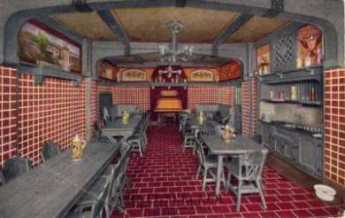Related Topics
Particular Sights to See:Center City
Taxi drivers tell tourists that Center City is a "shining city on a hill". During the Industrial Era, the city almost urbanized out to the county line, and then retreated. Right now, the urban center is surrounded by a semi-deserted ring of former factories.
Montgomery and Bucks Counties
The Philadelphia metropolitan region has five Pennsylvania counties, four New Jersey counties, one northern county in the state of Delaware. Here are the four Pennsylvania suburban ones.
Henry Mercer's Rathskeller

|
| Racquet Club |
RRathskeller was originally the name for a restaurant in the basement of a German City Hall, where the town Council would gather privately and make deals. That's quite different, by the way, from a Bavarian beer garden, which is a restaurant attached to a brewery where the public sings patriotic songs. Philadelphia used to have lots of both beer gardens and rathskellers, until World War I made German culture unpopular here, and the Volstead Act made beer illegal. In many ways, the most important surviving rathskeller in Philadelphia is in the basement of the Racquet Club. Surprisingly, it has only been a rathskeller for about twenty years.
Horace Trumbauer built the club on 16th Street in 1906, but by 1907 parts of it were still unfinished. He invited a fellow member of the club, Henry Mercer, to design the hang-out in the basement. Mercer, who was then known mainly as the curator of the University of Pennsylvania Museum of Archeology, was to go on to become famous for his factory producing tiles of burnt clay in Doylestown. The grotto in the Racquet Club basement was to be his laboratory for developing a style of poured-in-place concrete construction, with "Mercer" tiles embedded in the walls and particularly the floor. Mercer's own mansion and museum, built in Mercer style, are next to his pottery in Doylestown; not everyone is thrilled with the Mercer style, but it is not easily forgotten.
The grill room, or wine room, of the Racquet Club was built around a concept. It was to have an enormous stove or grill, serving club members oysters, steaks and chops with lots of beer, twenty-four hours a day, seven days a week. That sort of eating and drinking is now uncommon, and one club historian has remarked that most of the members who enjoyed that sort of lifestyle, probably died of it. To symbolize that the door to the grill was always open, the key was buried under a Mercer tile in the huge fireplace. Inscribed on the tile was the Latin motto, "DUM CLAIM TEAM". Off in a side area were four bowling alleys, now covered over because of disuse. With a huge fireplace and an even huger grand grill lit twenty-four hours a day, the place was said to get a little warm in the summer. The area has since been air-conditioned, but its popularity will probably return only when Prohibition does.
Henry Mercer liked poured concrete walls, which at their best are gloomy grey, and with a big fireplace can soon get dark and dirty. As the lights in Mercer's home, the light bulbs were dim, even flickering. It is impossible to imagine a college fraternity house with more appeal to young males than the wine room of Philadelphia's socialite Racquet Club. However, with the decline in popularity of the room which parallels Philadelphia's restaurant revolution, the idea finally gained acceptance that salvation lay in pepping up the grotto.
So, in the 1980s, the walls were painted white, the light bulbs were increased in strength, the ceiling was lowered, and four ceramic wine barrels were placed next to the fireplace. As a final touch, several dozen flags of various nations were stuck in the walls around the room. The historic laboratory in which the Mercer style was developed and made famous, was transformed into somebody's idea of a Rathskeller. At Friday lunch, the rafters ring with the gaiety of the Right Angle Club, most of whose members have heard of Mercer, but somehow never had time to go look at his museum.
Originally published: Thursday, June 15, 2006; most-recently modified: Tuesday, May 21, 2019